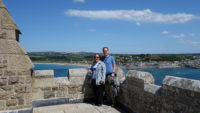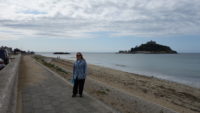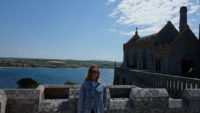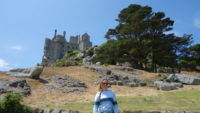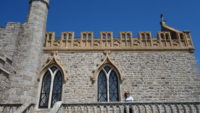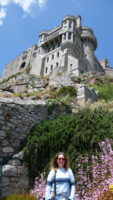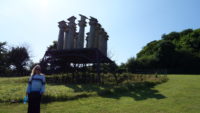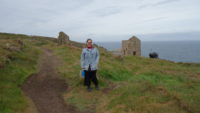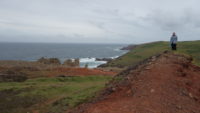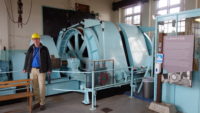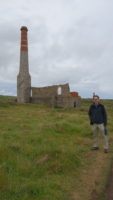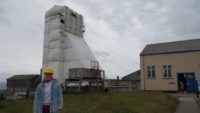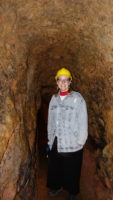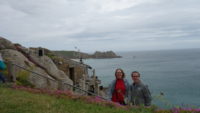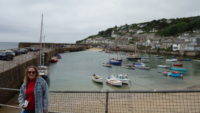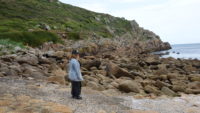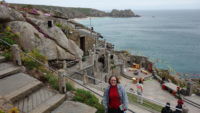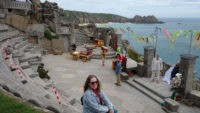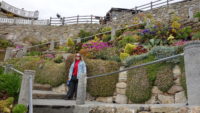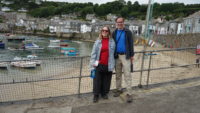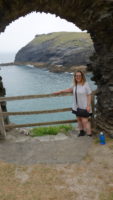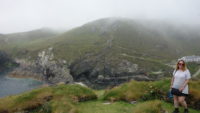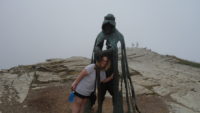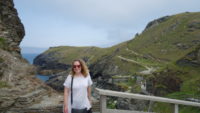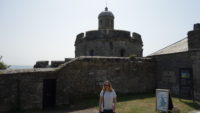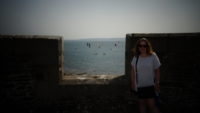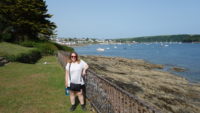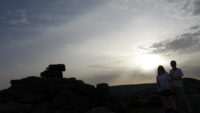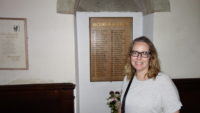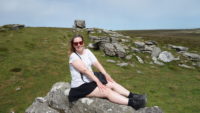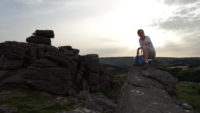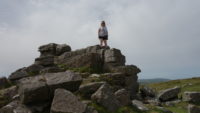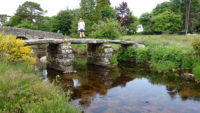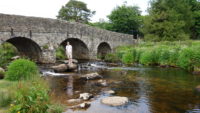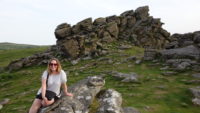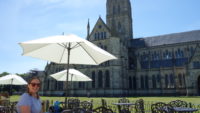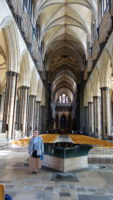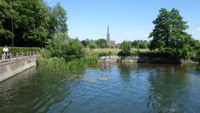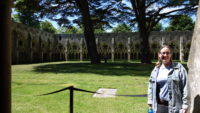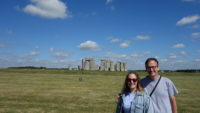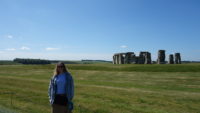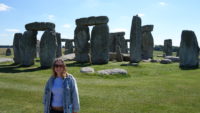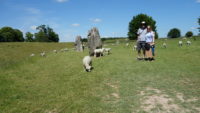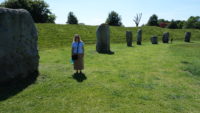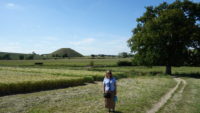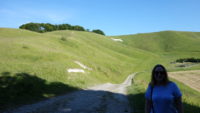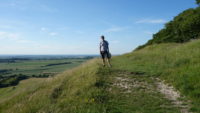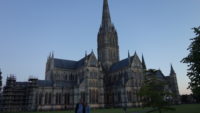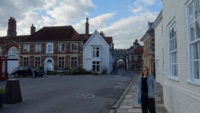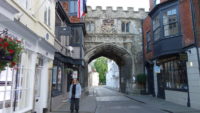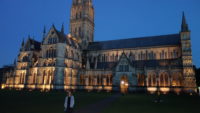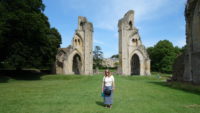 Sometimes the moon, stars, and planets all align. Because of how the trip scheduling worked out, Mer ended up taking us to Glastonbury today. For those, like me, who may not be familiar with the town, Glastonbury is the supposed burial place of King Arthur and Guinevere. In recent decades it has become a New Age pilgrimage place, and is also home to a Woodstock-style farm-field music festival. Mer decided to go to Glastonbury today. Two days before the festival starts. On the summer solstice. It was an interesting place to people watch today.
Sometimes the moon, stars, and planets all align. Because of how the trip scheduling worked out, Mer ended up taking us to Glastonbury today. For those, like me, who may not be familiar with the town, Glastonbury is the supposed burial place of King Arthur and Guinevere. In recent decades it has become a New Age pilgrimage place, and is also home to a Woodstock-style farm-field music festival. Mer decided to go to Glastonbury today. Two days before the festival starts. On the summer solstice. It was an interesting place to people watch today.
The people in town today were perfectly behaved and pleasant. Every third man seemed to have lost his shirt, which may have been the same place every third woman lost her bra. Every fourth man and woman were barefoot, but they made up for lack of footwear with the presence of numerous walking staffs. Hair was worn one of three ways – long, colored an unusual color (blue was popular), or long and colored. Every fifth person was carrying a guitar or drum. One man was happy in just his loincloth. Many people seemed to be smoking … something. As I said, it was an interesting place to people watch today.
We were there to see the remains of the ruined abbey in town. Love me a good ruined abbey. I haven’t seen any since March in Ireland. Glastonbury Abbey is so ancient that no one knows when it was founded, but it is attributed to Joseph of Arimathea (of Bible fame). Legend has it that Joseph came to Britain to trade for tin or lead. He brought eleven followers and the Holy Grail with him, and he founded a church where the abbey is located. Archaeology has found the remains of buildings on the site from at least 400, so any way you look at it, the church is old.
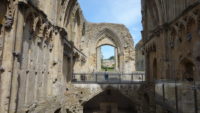 The king paid to have the church rebuilt, but the pilgrim connection to Joseph seems to have been damaged, and the abbey struggled. Enter King Arthur, or at least his body. The abbey claimed to have found Arthur and Guinevere together in a tomb buried on the grounds, and they made a grand tomb for him in a huge new church that was built onto the smaller previous church. That did the trick – pilgrims came in hordes, and the abbey was either the wealthiest or second wealthiest (after Westminster), depending on the year.
The king paid to have the church rebuilt, but the pilgrim connection to Joseph seems to have been damaged, and the abbey struggled. Enter King Arthur, or at least his body. The abbey claimed to have found Arthur and Guinevere together in a tomb buried on the grounds, and they made a grand tomb for him in a huge new church that was built onto the smaller previous church. That did the trick – pilgrims came in hordes, and the abbey was either the wealthiest or second wealthiest (after Westminster), depending on the year.
Enter Henry VIII. When the abbot of Glastonbury Abbey refused to close down the monastery and give it to Henry, and instead just continued on, Henry sent three officials to find something wrong. The tried to get the abbot on treason, but it wasn’t treasonous to run an abbey, so they eventually got him on trumped-up charges of theft. And they promptly executed him as a traitor (making the eighty-year-old carry his own scaffold up the nearby five-hundred-foot Tor hill), hanged him, then had him drawn and quartered, and then put his head over the abbey gate. Henry has much for which to answer.
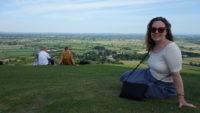 The abbey was looted for anything valuable, and that included the lead roof and the lead in the windows. Therefore, the abbey fell into ruin and eventually passed into private hands, when it was “mined” for stone. So, much of the abbey is gone. What still remains is impressive – the church walls still give an idea of the space, and the church built around 1200 was the biggest building in all of England at the time.
The abbey was looted for anything valuable, and that included the lead roof and the lead in the windows. Therefore, the abbey fell into ruin and eventually passed into private hands, when it was “mined” for stone. So, much of the abbey is gone. What still remains is impressive – the church walls still give an idea of the space, and the church built around 1200 was the biggest building in all of England at the time.
We read up on the abbey in the small museum on site, and then had an excellent guided tour of the grounds. We wandered around a little on our own as well, but Mer had more plans in town. Or, more accurately, slightly outside of town.
We took the mile-plus walk out to and up the Glastonbury Tor, the obviously towering hill right on the edge of town. We had some trouble finding the access path, and met two friendly guys from Liverpool. I understood most of every other sentence, but they seemed to indicate we should follow them. Which we did, and thus found the way up the back (steep) side of the Tor. We passed by four tents set up next to the “no camping” sign, and huffed our way up to the top of the hill. The views are magnificent in all directions. There were a ton of people up at the top, and it was a little distracting in that most seemed to be ingesting something from a bottle or a pipe, while one man treated the old church tower as his personal amplifier for his music. Again, everyone seemed well behaved, but it was hard finding a quiet and smoke-free place to sit. We did manage, and enjoyed twenty minutes just looking over the fields and hills of the area.
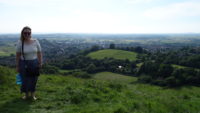 The walk down was easier and faster, and we went back into town for supper. After that, we drove to our B and B in the close-by town of Wells, which we will explore tomorrow. If we can get some sleep on the longest day of the year.
The walk down was easier and faster, and we went back into town for supper. After that, we drove to our B and B in the close-by town of Wells, which we will explore tomorrow. If we can get some sleep on the longest day of the year.
